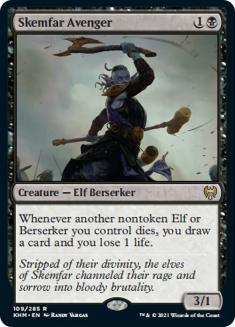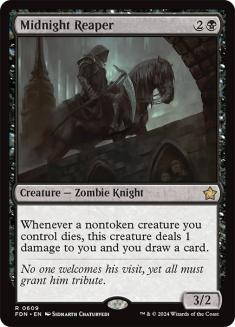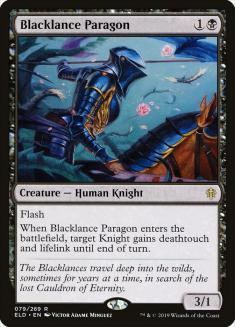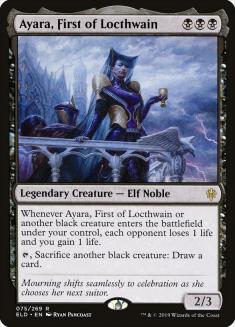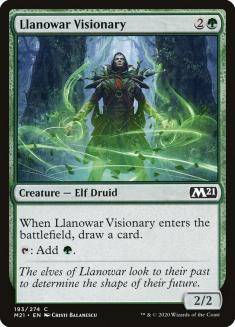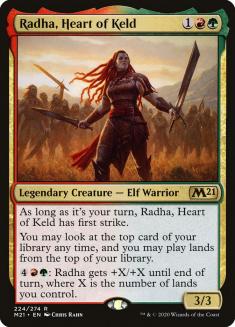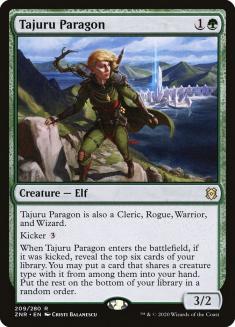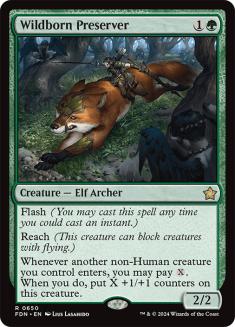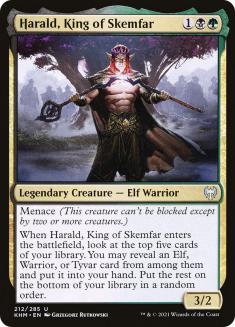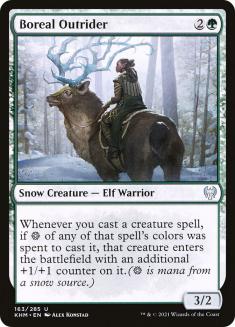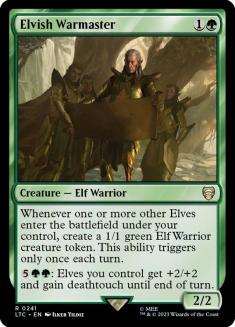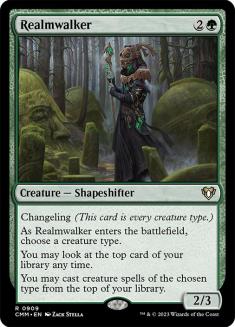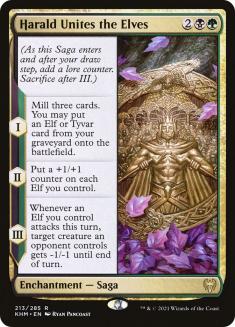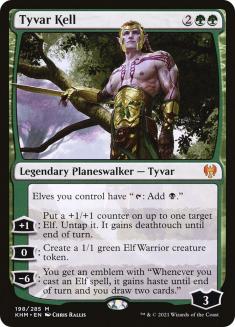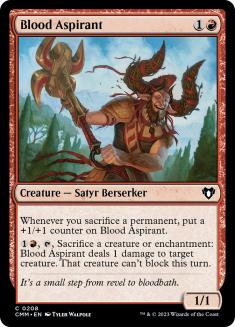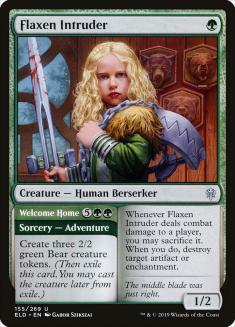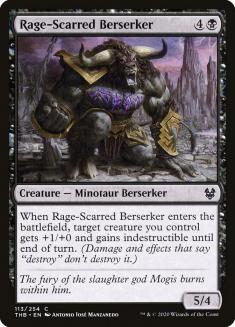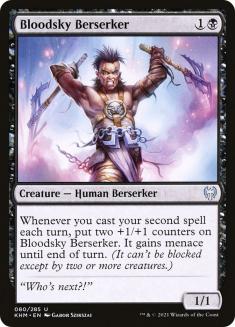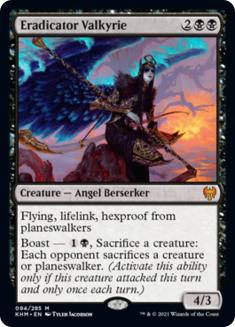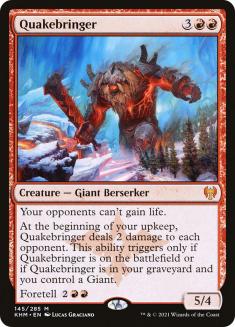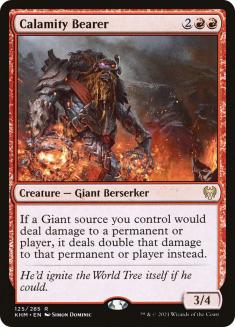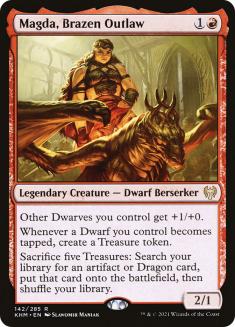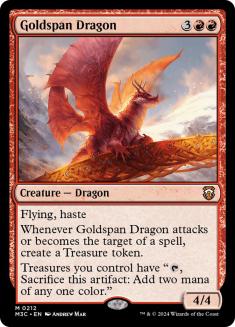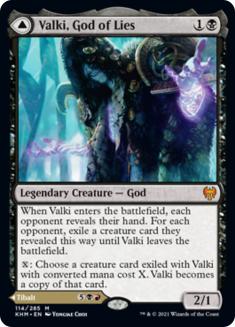Standard right now is a bit lacking in diversity of aggressive decks. Gruul Adventures is undoubtedly Tier 1, but every deck after that is either midrange, control, or aggro-control, with most other flavors of aggressive decks falling behind. The card Wizards of the Coast (WotC) gave me to preview might help change things in this regard, bringing more diversity of colors and themes to aggressive decks in the format.
Without further ado, here’s Skemfar Avenger!
The first thing we should notice with Skemfar Avenger is the obvious comparison to Midnight Reaper. Given that Midnight Reaper is a Standard and Historic staple, this bodes well for our new friend.
That said, there are some key differences:
- Midnight Reaper works on any creature type. This means you can throw it in way more decks, as all you really need is a way to sacrifice your creatures. The Cauldron Familiar + Witch’s Oven combo, for example, would not trigger Skemfar Avenger, which means you wouldn’t play it in that deck. Clearly to play Skemfar Avenger you need to be playing either a tribal Elf or Berserker deck, or at least a deck in which most creatures happen to be Elves or Berserkers, even if there is no other tribal component.
- Midnight Reaper triggers off itself. A creature like this is usually a lightning rod for removal, and it will be the first one they try to kill, so not replacing itself is a big negative.
- Skemfar Avenger is an Elf Berserker, which are two relevant creature types. Midnight Reaper also had relevant types — Zombie Knight — but I don’t think they were as relevant. You will actively play the Avenger because you want an Elf or because you want a Berserker.
- Skemfar Avenger costs two mana. This is the biggest positive towards the card and it makes it operate on a completely different axis as Midnight Reaper, to a point where I’m willing to ignore all of its other flaws. You see, the bar for a three-drop is big — you need your three-mana creature to be good to be able to compete. For a two-drop? Not so much. Many decks just want a two-drop that they can play, as evidenced by the fact that Blacklance Paragon even saw play outside of Knights decks.
I think this is a fundamental shift in how the cards play out because, with Midnight Reaper, you have to really want the effect to justify a 3/2 creature for three mana; your entire deck has to be built to abuse it, with sacrifice effects and recursion. With Skemfar Avenger, not so much. A 3/1 for two mana isn’t the best deal in the world, obviously, but it’s also an entirely passable aggressive two-drop, and the ability is just a bonus (a bonus without which you would never play this, but a bonus nonetheless).
Sometimes you will be in combat and some Elves or Berserkers will die and you’ll draw a card. Sometimes your opponent will want to kill another of your creatures and you will draw a card. Sometimes your opponent will cast a sweeper and you will draw many cards. Sometimes you’ll have two of these on the battlefield. It’s not a way for you to acquire incredible advantages and bury your opponent in extra cards, but it is a way for you to make weird attacks and not be punished for it, or to be able to overextend without fearing a sweeper.
In the end, these two cards demand different things. Skemfar Avenger demands that you’re an aggressive deck with many creatures of specific creature types, whereas Midnight Reaper demands that you’re capable of triggering its ability a lot. Even though the two cards look remarkably similar, you will not be able to understand Skemfar Avenger’s true potential if you just look at it as another Midnight Reaper. Rather, you need to look at it as another Blacklance Paragon (and a better one most of the time).
So, where exactly would you play Skemfar Avenger? Well, as we’ve established, I think you need to be an aggressive deck, because the 3/1 body for two mana is an integral part of the card. You also need to have many Elves and Berserkers, ideally cheap ones, since you want its ability to trigger; you don’t want to play just a 3/1 for two mana. Sacrifice effects and recurring creatures are good, but not necessary.
Neither Elf nor Berserker is a supported tribe right now, but Kaldheim is poised to change that. We don’t know the entire set, so these decks will certainly have to be updated later on, but there’s already enough to build a skeleton. Let’s see where Skemfar Avenger might fit in.
Elves
Elves are usually a “mana” tribe, rather than an aggressive tribe; you’re trying to cast small Elves into a big finish, whether that’s a large creature or a Glimpse of Nature-fueled combo. In Kaldheim, things seem to be a bit different. The addition of black has turned them more towards aggression, similarly to how Golgari Elves behaved all the way back in Lorwyn, where it was one of the best decks. These are the playable Elves currently in Standard:
These are the interesting Elves currently previewed from Kaldheim:
Harald, King of Skemfar is a very good card. A three-mana 3/2 menace that replaces itself with some selection is very strong, and if you build your deck well this is usually going to accomplish that; with twenty targets, it has an 88% chance to hit, and with 25 it becomes 94%. It is legendary, which is not great, but extras aren’t useless, as the ability will still trigger and, if you happen to have Skemfar Avenger on the battlefield, you also draw a card from it.
Assuming all your basics produce snow mana, Boreal Outrider seems relatively easy to trigger and basically gives all your new creatures +1/+1. Is this good enough? I don’t think so unless we’re really looking for a three-drop Elf (and I don’t think we will be when the set is fully previewed).
A 3/3 lord is interesting, but I think at four mana there are better Elf-centric cards in this set than Canopy Tactician.
Another good two-drop, Elvish Warmaster will generate some tokens over the course of the game and then will give you a strong mana sink later on.
Skemfar Shadowsage is potentially a finisher but, again, the four-drop slot will be crowded with better cards.
A 2/3 for three mana has weak stats, but Realmwalker’s ability can be quite strong. There are currently no one-mana Elves that I want to play, but there are some two-drops already and we might see more cheap creatures in the future.
On top of the Elves, there are also the Elf-centric cards I mentioned before:
Harald Unites the Elves seems very good to me as well. The first chapter will likely end up wasting mana or being even — I can’t imagine we’ll play many five-mana Elves — but between mill-three and creatures just dying normally over the course of the game, we should usually hit something. You’re likely to have at least a couple of creatures lying around for the second chapter, so that’s obviously helpful, and then the third chapter lets you basically dominate combat (remember that it triggers for each Elf).
So, imagine a game where you cast an Elf on Turn 2, which died, and an Elf on Turn 3. Then, on Turn 4, you cast this and get your two-drop back. On Turn 3 you gain +2/+2 worth of permanent stats and cast another Elf, and on Turn 4 you get to attack and distribute three -1/-1s, which is usually going to be enough to kill a creature or stop your opponent from blocking altogether. This seems strong to me and the average use of this card, and it can get much better if you’ve been generating extra creatures with, say, Elvish Warmaster.
The new Elf planeswalker — covered by Michael Majors yesterday — Tyvar Kell should probably slot in most Elf decks. Its passive ability potentializes all your digging cards like Realmwalker and Harald, King of Skemfar; its 0 ability fuels your swarm-based cards; and its ultimate will win any grindy game by itself. It even offers a bit of color fixing! On top of that, between Harald, King of Skemfar and Harald Unites the Elves, it’s going to be relatively easy to find.
Here’s how I would build the deck right now:
Creatures (23)
- 4 Tajuru Paragon
- 4 Kazandu Mammoth
- 3 Realmwalker
- 4 Elvish Warmaster
- 4 Harald, King of Skemfar
- 4 Skemfar Avenger
Planeswalkers (5)
Lands (18)
Spells (14)

This deck will not be nearly as fast as something like Gruul Adventures, but it is very resilient. Between Realmwalker; Skemfar Avenger; Tajuru Paragon; Harald, King of Skemfar; and Agadeem’s Awakening, it should have plenty of access to extra cards to be very good versus removal spells. Hopefully Kaldheim brings us a good aggressive one-drop Elf so that the focus of the deck can become more aggressive (and if we do get one we might even be able to play Wildwood Tracker as an extra one-drop).
Berserkers
Unlike Elves, Berserkers have never been a supported tribe; there are, in fact, very few Berserkers in Magic. We do know, however, that Berserkers will likely have an even more aggressive focus than Elves, which might make them an even better home for Skemfar Avenger.
Here are the Berserkers in Standard:
As we can see, Kaldheim will have to do a lot of the heavy lifting. Can it? I think so, but not many Berserkers have been previewed so far, so it’s hard to say.
One thing to keep in mind is that, even though Berserker is a tribe, it doesn’t seem to be as “tribal” as Elves, which has several cards that require more Elves to work. Tajuru Paragon, Elvish Warmaster, Realmwalker, Harald, Harald Unites the Elves, and Tyvar Kell all limit the way you build your deck as they all want the bulk of your creatures to be Elves. With Berserkers, it looks like you’re more free to actually have a mix, since creatures happen to be Berserkers rather than having Berserker synergies. Let’s look at the new cards:
These Rakdos decks are usually not made to cast two spells in the same turn constantly, but you only need to do it once for Bloodsky Berserker to be reasonable. If there are some good one-drops, you could end up playing this and a one-drop on Turn 3, for example. Overall I don’t think this is good enough but it has outs to be good depending on what we see.
Eradicator Valkyrie has a lot of words, but I don’t think it actually fits what a Berserker deck is trying to do. I imagine these decks as almost Mono-Red Aggro decks in theme.
Quakebringer and Calamity Bearer will likely go together. I think for the most part you want your deck to be smaller, but these are two Giant Berserkers already, and Bonecrusher Giant is also an insane Giant, so there might be something there depending on what else we see (even though Giants is the Izzet tribe).
Magda, Brazen Outlaw is a Dwarf tribal card, but it also happens to be a Berserker. I honestly think it’s strong enough to see play even as the only Dwarf in your deck.
Not a Berserker, but a very powerful card in these colors, especially with Magda, Brazen Outlaw.
Also not a Berserker, but a perfect card to put in a Magda and Goldspan Dragon deck, as it’s an early-drop that works as a mana sink.
At this point, it looks like there’s enough to play a Rakdos deck for certain, but not enough to make a Berserkers deck. The only other Berserker I currently want to include is Magda, Brazen Outlaw, and I don’t think this is enough to justify playing Skemfar Avenger. However, I don’t think we need a lot, and if we get a couple more this will already be enough. Assuming we’re getting at least another two more playable Berserkers for an aggro deck (with costs ranging from two to four), this is how I would build the deck:
Creatures (21)
- 4 Bonecrusher Giant
- 3 Anax, Hardened in the Forge
- 3 Magda, Brazen Outlaw
- 3 Valki, God of Lies
- 4 Goldspan Dragon
- 4 Skemfar Avenger
Lands (20)
Spells (11)

You might have noticed that this is only 52 cards. The remaining eight are saved for future Berserker creatures that we may get.
In the end, it’s hard to say if either of these two decks can work. I think that as of right now they are both not where they need to be, but there are still many cards to be seen, so no tribal deck is going to feel complete at this point in time.
In this regard, I think Berserkers has an edge, as a lot of Elf-specific cards have already been previewed but the same is not true for Berserkers. On top of that, the Elf cards seem to pigeonhole you too much into playing all of the Elf cards, whereas the Berserkers seem to offer you more flexibility, so this is where I would bet my chips as far as a Skemfar Avenger deck goes.


